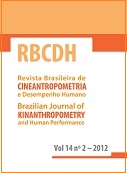Estimated VO2max and its corresponding velocity predict performance of amateur runners
DOI:
https://doi.org/10.1590/1980-0037.2012v14n2p192Abstract
In recent years, there has been a substantial increase in the number of runners, with a proportional increase in their involvement in amateur street competition. Identification of the determinants of performance in this population appears necessary for optimization of time devoted to training. The objective of this study was to ascertain the association between estimated maximal oxygen uptake (VO2max), critical velocity (CV) and VO2max velocity (VVO2max) and athletic performance in the 3.6 km (uphill) and 10 and 21.1 km (flatland) events. Twelve amateur runners (nine male), mean age 36 ± 5 years underwent five tests: 1 and 5 km race on level ground, 3.6 km race with slope (?8%), and indirect VO2max measurement. CV was determined from the linear relationship between distance and run time on the first two tests. The subjects then took part in two official 10 km and 21.1 km (half marathon) races. VVO2max was calculated from the VO2max through a metabolic equation. VO2max showed the best association with running performance in the 10 and 21.1 km events. For the uphill race, VVO2max showed a better association. Overall, the variable with the highest average association was VO2max (0.91±0.07), followed by VVO2max (0.90±0.04) and VC (0.87±0.06). This study showed strong associations between physiological variables established by low-cost, user-friendly indirect methods and running performance in the 10 and 21.1 km (flatland) and 3.6 km (uphill) running events.



